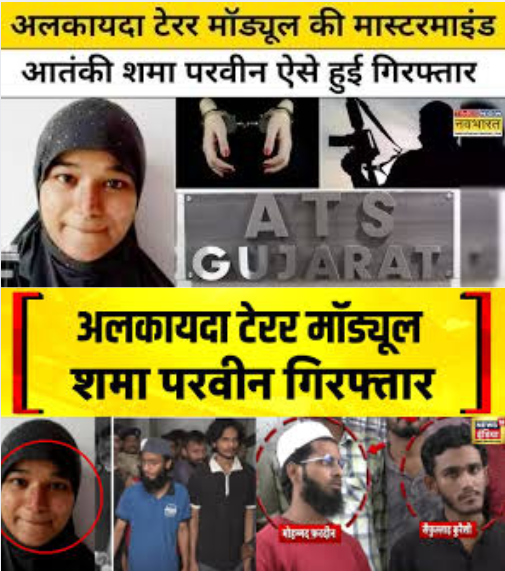Al-Qaeda terror module mastermind Shama Parveen arrested by Gujarat ATS
The Gujarat Anti-Terrorism Squad (ATS) has achieved a significant breakthrough by arresting a female operative linked to Al Qaeda’s Indian affiliate, Al Qaeda in the Indian Subcontinent (AQIS). On July 29, 2025, in a carefully coordinated operation, Shama Parveen, a 30-year-old woman originally from Jharkhand and residing in Bengaluru, was detained for her alleged role as the mastermind behind an online radicalization and recruitment module.
Shama Parveen’s arrest came after the detention of four other suspects earlier in July from various cities—Ahmedabad, Delhi, Noida, and Modasa. These four men—Mohammad Faiq, Mohammad Fardeen Shaikh, Saifullah Qureshi, and Zeeshan Ali—were all allegedly involved in spreading extremist ideology via social media, working under the umbrella of AQIS. According to officials, Parveen played a leading role in orchestrating the module, managing multiple social media accounts to distribute propaganda, radicalize Indian youth, and connect with operatives in Pakistan.
Parveen was arrested from her residence in the Hebbal area of Bengaluru. Gujarat ATS had been monitoring her online activity for several months before confirming her connection to the other suspects. Initial questioning revealed that she operated at least three major social media accounts—two on Facebook and one on Instagram—where she regularly posted extremist content, including speeches and videos from well-known Al Qaeda leaders like Asim Umar, the former AQIS chief, and Anwar al-Awlaki, an influential jihadist cleric. These posts included calls to overthrow the Indian democratic system, encourage sharia law, and instigate violence in the name of religion.
Officials say she had direct digital contact with individuals based in Pakistan through encrypted messaging apps and international WhatsApp numbers. Preliminary investigations indicate that Parveen was actively receiving ideological instructions and perhaps even logistical guidance from handlers outside India. While funding trails are still under investigation, her phones and other electronic devices have been seized and are undergoing forensic analysis to trace any foreign transactions or transfers.

According to law enforcement sources, Shama Parveen comes from an ordinary background. She is a graduate with a B.Com degree and had been living with her mother and brother in Bengaluru for the past few years. Though she was not professionally employed at the time of arrest, her online activity suggests she spent substantial time managing digital operations on behalf of AQIS. Gujarat ATS noted that her content was designed to attract, influence, and eventually indoctrinate vulnerable youth by mixing religious sentiment with anti-government rhetoric.
The four other men arrested before her were also found to be operating online propaganda cells. One of them, Mohammad Fardeen, had uploaded a video threatening violence and was found with a sword and literature calling for an armed uprising against the Indian state. Another, Mohammad Faiq from Delhi, was reportedly in contact with multiple Pakistan-based Instagram accounts and was tasked with promoting jihadist narratives online. These operatives worked independently on different platforms but were ideologically and operationally linked to the same module, allegedly supervised by Parveen.
All five suspects have been booked under multiple sections of the Unlawful Activities (Prevention) Act (UAPA), including those related to promoting terrorism, recruiting for a banned organization, and conspiring against the nation. In addition, provisions from the Bharatiya Nyaya Sanhita (India’s updated criminal code) have been invoked for acts endangering sovereignty, promoting enmity, and attempting to overthrow constitutional institutions.
Investigators say that the entire operation was intelligence-led. The ATS had been monitoring social media pages promoting violent extremism since early June 2025. Specific posts referencing anti-national activities and praising known terrorists led authorities to track down the individuals behind them. After arresting the four men and retrieving critical data from their devices, authorities established Shama Parveen’s identity and location. Her arrest from Karnataka confirms that the terror network had expanded its influence far beyond Gujarat and into southern India.

Authorities stress that this is a rare case involving a female mastermind behind an Islamist terror module. While women have occasionally been involved in extremist circles, it is unusual for them to be in operational command. Shama Parveen’s role in managing online cells and maintaining direct connections with foreign handlers marks a shift in the way terror groups like AQIS are decentralizing operations and using less conventional actors.
The case has also raised alarms about the use of social media for extremist recruitment. Platforms that were once dismissed as benign are now seen as significant battlegrounds for ideological warfare. Officials believe that the arrested suspects had started grooming new recruits, some of whom may still be active or under the radar. Forensic teams are currently analyzing chats, shared content, and metadata to uncover the extent of the network and whether it connects with other sleeper cells within India.
This latest bust is part of a larger trend where Indian counterterrorism agencies are focusing on cyber radicalization. Earlier in 2025, a Gujarat-based 18-year-old youth was arrested for hacking more than 50 government websites in a coordinated operation allegedly linked to an anti-national campaign. That individual was reportedly influenced by online extremist content, further confirming how ideology is spreading digitally across the country.
As of now, Shama Parveen has been brought to Ahmedabad under transit remand and is expected to be formally presented in court for extended custody. Investigators hope that interrogation and digital data recovery will help them identify others involved in the module, map foreign funding channels if any, and determine whether any offline attacks were being planned.

Security agencies are also reaching out to social media platforms for cooperation in tracing the digital footprints of the accused. Meanwhile, awareness campaigns are being considered to help families and communities identify early signs of radicalization among youth, especially in urban areas where internet access is high and supervision may be minimal.
Authorities have expressed concern about how terrorist organizations are adapting to modern platforms and decentralizing their messaging. The use of women, particularly those with educational backgrounds and strong digital literacy, marks an evolution in the recruitment and operational models of groups like AQIS. It also highlights the difficulty in identifying threats early, especially when operatives operate anonymously behind multiple accounts.
In conclusion, the dismantling of this AQIS-linked module by Gujarat ATS is not just a tactical success but also a warning sign. It underscores the need for continuous monitoring of online spaces, greater coordination between states, and increased public awareness about the evolving nature of terrorism in the digital age. With investigations ongoing and more arrests possibly on the horizon, India’s security agencies remain alert to neutralize threats not just from across borders, but also from within.
Play video :
News
Payal Malik Punished For Creating Kali Maa Look Washed Pots In Temple
Payal Malik Punished For Creating Kali Maa Look Washed Pots In Temple In recent days, Bollywood and its digital influencer…
No No This Can’t Be True! Tanushree Dutta Makes Serious Allegations Against Salman Khan
No No This Can’t Be True! Tanushree Dutta Makes Serious Allegations Against Salman Khan In a dramatic and emotionally charged…
Who is Udita Goswami? Saiyaara Director Mohit Suri’s Wife Was Most Sexist Actress In Bollywood
Who is Udita Goswami? Saiyaara Director Mohit Suri’s Wife Was Most Sexist Actress In Bollywood In an age where thrillers…
Dilip Joshi With Real Wife, Munmun Dutta And All Stars Of Taarak Mehta Ka Ooltah Chashmah
Dilip Joshi With Real Wife, Munmun Dutta And All Stars Of Taarak Mehta Ka Ooltah Chashmah In the vibrant and…
Big bad news about Bharti Singh! Bharti Singh Sad News! Bharti Singh Full Story and Biography
Big bad news about Bharti Singh! Bharti Singh Sad News! Bharti Singh Full Story and Biography Bharti Singh, known as…
The worst news has come that Bharti Singh will go to jail because of the maid Manisha
The worst news has come that Bharti Singh will go to jail because of the maid Manisha For several years,…
End of content
No more pages to load












